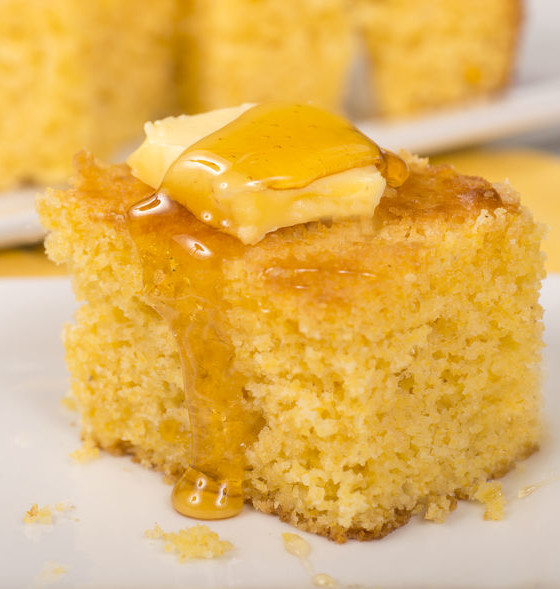
Cornbread
Also known as maize bread
What is Cornbread?
Cornbread is a special bakery product made from a chemically-leavened batter in the U.S. or from yeasted dough in Europe and other parts of the world.
Typically, dough-based cornbread has a:
- Tight crumb grain
- Golden crumb color
- Unique aroma and sweetness provided by the corn
However, when it’s made as a sweet good, it resembles the texture and flavor of a muffin.
Formulation for yeast-leavened cornbread1
| Ingredients | Baker’s % (based on flour weight) |
| Bread flour | 80.0–70.0 |
| Cornmeal | 20.0–30.0 |
| Water | 55.0–63.0 |
| Salt | 1.5–2.0 |
| Nonfat dry milk | 3.0–5.0 |
| Compressed yeast | 1.0–1.5 |
| Olive oil (extra-virgin) | 3.0–5.0 |
Processing of dough
- Ingredient scaling.
- Mixing
- Add cornmeal and total amount of water to the mixer bowl. Allow mixture to soak for about 15 minutes, softening the cornmeal and improving the dough handling properties.
- Add the rest of the ingredients and mix for 120 seconds on low speed to incorporate dry and liquid ingredients.
- Continue mixing on high-speed to full gluten development. Final dough should be extensible, with limited elasticity and resistance to deformation.
- Final dough temperature should be 76°F (24°C) which can be controlled by adjusting water temperature with ice or by using refrigerated equipment.
- Care must be exercised to not overmix the dough as corn particles exert a cutting action or weakening effect on the gluten matrix.
- Bulk fermentation. Allow dough to ferment for about 90 minutes at 82°F (28°C) / 85% RH. Degassing the dough by punching should be done at about mid-fermentation time.
- Dividing. Scaling weight is usually 600 g but can vary depending on the desired finished product.
- Intermediate proofing (resting): allow dough to recover from mechanical work for 5 to 15 minutes at room conditions.
- Moulding. Forming of round or oval loaves.
- Final proofing. Proof dough pieces at 92–95°F (33–35°C); 85% RH for 30–60 min.
- Scoring or topping (optional).
- Top of loaves can be dusted with cornmeal.
- Alternatively, loaves can be scored to provide different oven spring patterns and special features to the baked goods.
- Baking. Bake at 460°F (238°C) for about 40 minutes to an internal temperature of 204°F (95°C). Steam can be applied to enhance oven spring and color.
- Cooling to loaf internal temperature of 95–105°F (35–40°C) before packaging or serving.
- Packaging or serving
Formulation for chemically-leavened cornbread2
| Ingredients | Baker’s % (based on flour weight) |
| Dry | |
| Bread or pastry flour | 50.0 |
| Fine cornmeal | 50.0 |
| Salt | 2.0–2.2 |
| Sugar | 30.0–40.0 |
| Nonfat dry milk | 5.0–10.0 |
| Baking powder (slow-acting leavening acid) | 4.0–5.0 |
| Liquid | |
| Liquid whole eggs | 18.0–22.0 |
| Water | 65.0–75.0 |
| Corn syrup | 4.0–5.0 |
| Butter (or margarine) | 30.0–35.0 |
* Total batter hydrations range from 90 to 100%.
Processing of batter
- Ingredient scaling.
- Mixing (batter mixing).
- Combine all dry ingredients
- Combine all liquid ingredients. Butter or margarine should be melted prior to blending.
- Add liquids to dry ingredients and mix to form a homogeneous batter.
- Batter should be immediately processed to avoid loss of carbon dioxide gas that may cause poor volume in the finished product.
- Depositing or panning. Grease pan prior to depositing.
- Baking. Bake at 400°F (200°C) to an internal temperature of 204°F (95°C). This usually takes 25–35 minutes. The higher the oven temperature, the shorter the baking time.
- Depanning.
- Cooling to loaf internal temperature of 95–105°F (35–40°C) before packaging or serving.
- Packaging or serving.
Application
The water absorption rate depends on the mean particle size and particle size distribution of the cornmeal. The coarser the cornmeal, the longer it takes to fully hydrate, soften and incorporate into the dough or batter. The wider or the less uniform the particle size distribution, the more difficult it is to keep soaking and mixing times consistent batch after batch.
Water absorption of bread dough also depends on the protein content and flour strength of wheat flour.
The higher the cornmeal inclusion, the shorter the mixing time, and the lower stability and tolerance to overmixing. The mixograph or farinograph can be used to optimize mixing conditions and parameters.
References
- Hamelman, J. “Breads Made with Yeast.” Bread. A Baker’s Book of Techniques and Recipes, 2nd edition, John Wiley & Sons, Inc., 2013, pp. 143–144.
- Gisslen, W. “Quick Breads.” Professional Baking, 7th edition, John Wiley & Sons, Inc., 2017, p. 219.

